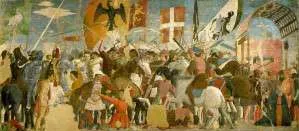The Basilica of St. Francis represents a crossroads between the city’s history, art and spirituality.
An essential stop during a stay in Arezzo is definitely this historic basilica, located near the famous Teatro Petrarca.
From the outside, the Basilica of St. Francis immediately reveals its incomplete architecture, as the facade has not been completed as planned since the 14th century. However, this detail should not deceive: inside hides a collection of artworks of immeasurable value.
Inside the Basilica of St. Francis, there is a treasure trove of artistic and pictorial works. Prominent among them is the world-famous cycle “The Story of the True Cross,” begun by Bicci di Lorenzo and completed mainly by Piero Della Francesca between 1452 and 1466. The frescoes adorn the “Bacci Chapel,” named after the Aretine merchant family Bacci, patrons of the basilica and its works of art, and are located behind the high altar.
Some partially visible frescoes, located near the renowned Ciclo, were painted by eminent Arezzo painters between the 14th and 15th centuries, including works by Spinello Aretino. Spinello’s works are also displayed in other significant places in Arezzo, such as the Basilica of San Domenico, and in the prestigious Uffizi Gallery in Florence.
The construction and external appearance of the Basilica of St. Francis
Followers of Francis of Assisi began construction of the church of St. Francis in Arezzo in 1290, on a pre-existing site of worship. It was designed according to the architectural styles of the time, with a single nave, and retains its Romanesque splendor today, contrasting with the Gothic style of the Cathedral of Arezzo located on the city’s highest hill.
The exterior facade, however, remained incomplete due to lack of funds allocated in the 14th century. It is said that in 1346 Monna Tessa contributed 300 liras, an insufficient sum to complete the work. Another attempt at construction took place in 1870, but with poor results as the structure was damaged. Only in 1990, 45 years after it was declared a Basilica, was the entrance modernized. The entrance, with a complex history, today reflects its past and opens onto the beautiful Square that bears the name of the Basilica.
The Basilica of St. Francis: the period of neglect and rebirth
This Basilica has suffered periods of neglect and damage caused by time. Many frescoes, dating from the 14th-16th centuries, have been damaged. The structure was abandoned in 1556 following a fire that severely compromised the structure. During the Napoleonic era and throughout the 19th century, the church lost its religious function, becoming a warehouse.
Recovery of the Basilica began in the 1900s with restorations aimed at saving the lost frescoes. Umberto Tarlati, director of the work, despite his efforts, failed to save many of the damaged works. However, he completed an enhancement of the interior, which today houses important works of art. The last restoration was in 2020, with the arrangement of the polychrome windows and the replacement of the small columns of the Guasconi Chapel, damaged by structural failure.
Today, the Basilica is a reborn monument, thanks to dedicated care after centuries of hardship. The church is undoubtedly a city treasure, which deserves a respectful visit and will surprise visitors as soon as they cross its seemingly austere threshold.
The Basilica of St. Francis and the B&B Cento Passi Dal Duomo
One thing that makes a visit to the Basilica of St. Francis even more special is its proximity to the B&B Cento Passi dal Duomo. Located just a few minutes’ walk away, our B&B offers an ideal starting point for exploring the artistic wonders of Arezzo, including the extraordinary frescoes by Piero della Francesca.
After a day immersed in the history and art of the city, guests can relax in a comfortable and welcoming environment, with the convenience of being just a stone’s throw from the main places of interest. Book your stay at the B&B Cento Passi dal Duomo and discover the magic of Arezzo.

